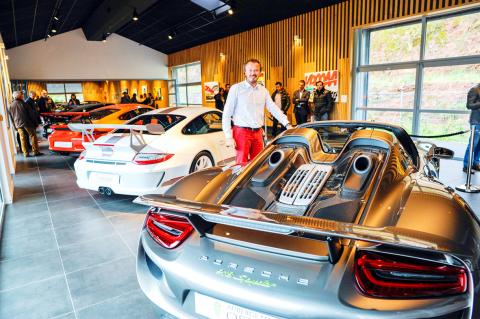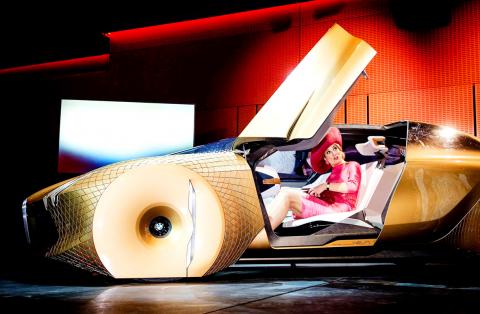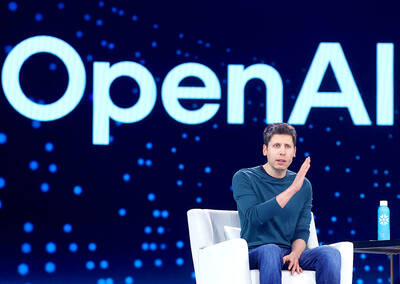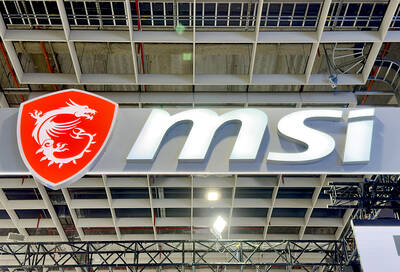Tokyo businessman Randal Furudera is not about to swap his German-made BMW M5 for a “boring” Japanese car, although he will give them some grudging respect for their ho-hum dependability.
Deep-pocketed buyers like Furudera are driving sales in Japan of high-end foreign brands, which dominate the niche sector in a car market long seen as all but shuttered to overseas automakers.
“Most Japanese cars these days are sort of becoming moving appliances,” the 54-year-old said.

Photo: AFP
“They’re very reliable, they’re good quality, they never break and all that, but they’re not very interesting to drive,” he said.
Mid-range foreign vehicles are a rare sight on Japanese streets, but it is not hard to spot a Porsche zipping around the capital or a nouveau riche billionaire behind the wheel of a half-a-million-dollar Lamborghini.
Sales of the Italian sportscar in Japan doubled to about 300 vehicles in 2015 from a year earlier.

Photo: EPA
The jump comes as US car giant Ford announced in January it was quitting the country, blaming the “closed” market, after it sold fewer than 5,000 cars last year.
Less than 6 percent of the more than 5 million vehicles sold last year in Japan — the world’s No. 3 car market — were made by foreign automakers.
US auto unions have blasted what they say are non-tariff barriers that shut the door on a sector already dominated by eight domestic carmakers, including Toyota, Nissan and Honda.
In 2013, former Ford boss Alan Mulally accused Tokyo of manipulating the yen’s sharp decline to gain a trade advantage for domestic firms, which sell millions of vehicles overseas, including top markets China and the US.
The imbalance has not gone unnoticed by US Republican party frontrunner Donald Trump.
“When did we beat Japan at anything?” Trump said in a speech last summer to announce his run for the presidency.
“They send their cars over by the millions, and what do we do? When was the last time you saw a Chevrolet in Tokyo? It doesn’t exist, folks,” he said.
Trump is not far off — Chevrolet and Cadillac maker General Motors sold a puny 1,600 vehicles in Japan last year.
However, it is a different story for prestige foreign brands, whose success did not come without a fight.
They had to “overcome stereotypes like Western cars break down easily or they are expensive to repair,” said Miki Kurosu, communications director for BMW Japan, which sold about 46,000 vehicles last year, along with 21,000 Minis.
Japan’s luxury car market has remained frothy despite a years-long downturn in the economy, while a stock market rally in recent years has also helped buoy sales.
Nissan considered selling its high-end Infiniti brand at home, as Honda did with Acura. However, those plans were scrapped owing to foreign automakers’ dominance in the market.
Rival Toyota has also struggled to score big with its Lexus in Japan, although sales have been on an upswing lately.
“Lexus is a bit behind. They had great ambitions when they launched the brand [at home] in 2005, but have not achieved their goals,” said Yoshiaki Kawano, an auto analyst at IHS Automotive.
German brands have slick marketing campaigns and a top-notch image in Japan, and rich drivers rarely switch brands so domestic automakers were late to the party.
“There is quite a bit of prestige attached to certainly the three main German brands,” Furudera said.
Foreign brands tend to focus on the driving experience, rather than just passenger comfort, the car enthusiast added.
In Japanese cars, “[passengers] are probably enjoying it more than the drivers — watching DVDs, getting a massage from their chairs — but the driver is not enjoying it that much,” Furudera said.
“In a German car, the driver gains the most — that’s kind of the big difference,” he said.
While he may consider buying a Lexus down the road, it is not likely to happen any time soon.
“I wouldn’t say never, but for now I think BMW still has the edge in terms of driving experience,” he said.

DIVIDED VIEWS: Although the Fed agreed on holding rates steady, some officials see no rate cuts for this year, while 10 policymakers foresee two or more cuts There are a lot of unknowns about the outlook for the economy and interest rates, but US Federal Reserve Chair Jerome Powell signaled at least one thing seems certain: Higher prices are coming. Fed policymakers voted unanimously to hold interest rates steady at a range of 4.25 percent to 4.50 percent for a fourth straight meeting on Wednesday, as they await clarity on whether tariffs would leave a one-time or more lasting mark on inflation. Powell said it is still unclear how much of the bill would fall on the shoulders of consumers, but he expects to learn more about tariffs

Meta Platforms Inc offered US$100 million bonuses to OpenAI employees in an unsuccessful bid to poach the ChatGPT maker’s talent and strengthen its own generative artificial intelligence (AI) teams, OpenAI CEO Sam Altman has said. Facebook’s parent company — a competitor of OpenAI — also offered “giant” annual salaries exceeding US$100 million to OpenAI staffers, Altman said in an interview on the Uncapped with Jack Altman podcast released on Tuesday. “It is crazy,” Sam Altman told his brother Jack in the interview. “I’m really happy that at least so far none of our best people have decided to take them

PLANS: MSI is also planning to upgrade its service center in the Netherlands Micro-Star International Co (MSI, 微星) yesterday said it plans to set up a server assembly line at its Poland service center this year at the earliest. The computer and peripherals manufacturer expects that the new server assembly line would shorten transportation times in shipments to European countries, a company spokesperson told the Taipei Times by telephone. MSI manufactures motherboards, graphics cards, notebook computers, servers, optical storage devices and communication devices. The company operates plants in Taiwan and China, and runs a global network of service centers. The company is also considering upgrading its service center in the Netherlands into a

NOT JUSTIFIED: The bank’s governor said there would only be a rate cut if inflation falls below 1.5% and economic conditions deteriorate, which have not been detected The central bank yesterday kept its key interest rates unchanged for a fifth consecutive quarter, aligning with market expectations, while slightly lowering its inflation outlook amid signs of cooling price pressures. The move came after the US Federal Reserve held rates steady overnight, despite pressure from US President Donald Trump to cut borrowing costs. Central bank board members unanimously voted to maintain the discount rate at 2 percent, the secured loan rate at 2.375 percent and the overnight lending rate at 4.25 percent. “We consider the policy decision appropriate, although it suggests tightening leaning after factoring in slackening inflation and stable GDP growth,”